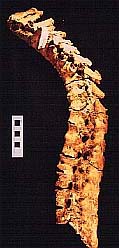 |
Ankylosing Spondylitis
Site: The Hirsel churchyard, Coldstream, Scotland.
Period: Medieval.
Excavator: Prof. R.J. Cramp, Durham University.
Published: forthcoming (Historic Scotland?).
Skeleton: male in old age.
Catalogue entry: This disease is an inflammatory arthritis of unknown cause, which works progressively up the spine from the pelvis, bringing increasing immobility as the joints are fused. It occurs mainly in men and usually begins at a relatively early age (c.30). This man had, however, survived into old age.
This case is a classic example of the disease, with fusion of the sacro-iliac joints and ankylosis of the complete thoracic and lumbar spine, including the costovertebral joints. The spine is almost completely rigid. In the lumbar vertebrae only the lateral edges of the vertebral bodies are joined, but the spinous processes have become a solid mass extending up to the T10 vertebra. The spine is kyphotic (bent forward) around the T8-9 area. The sterno-manubrial joint is also fused. |